by Matthew Orwat | Jul 28, 2013
Question of the Week. What is the name of this plant??? Please post your comments below. The answer will be revealed next week !
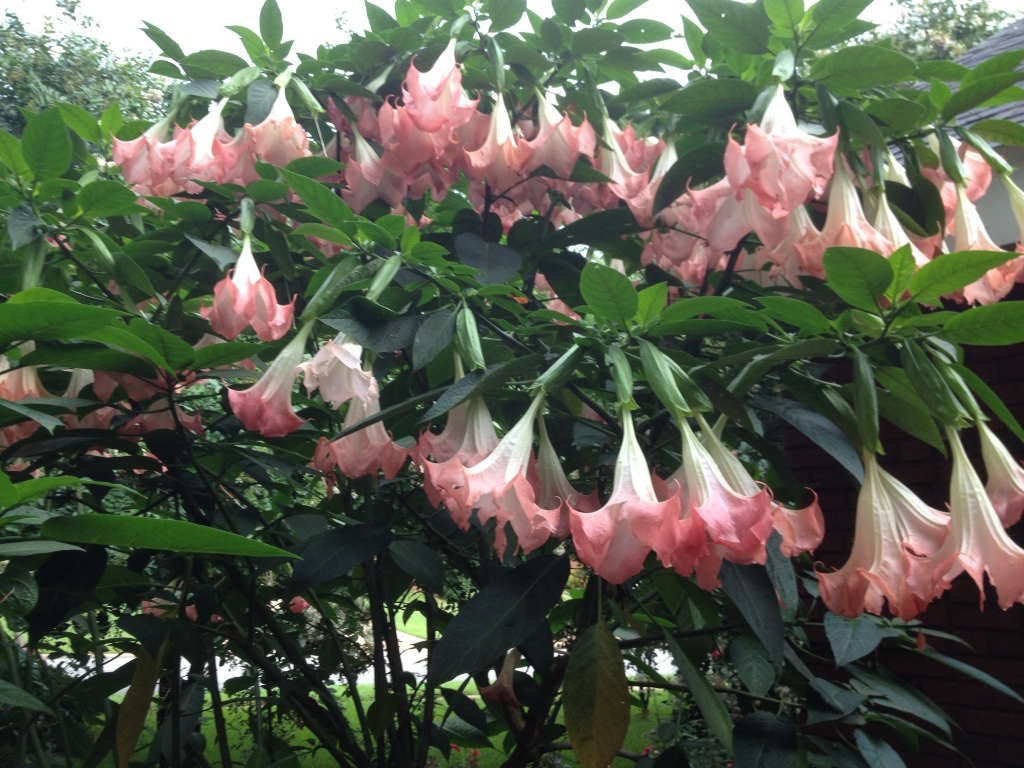
What it the name of this plant? Image Credit: Dr. Pete Vergot
The answer is Brugmansia spp.
Edward F. Gillman states in his publication:
“This small tree with large, 6- to 8-inch-long, simple leaves
makes a dramatic statement in any landscape. Reaching
perhaps to 15 feet tall, this densely foliated plant puts on a no
less than spectacular show when in full bloom in summer and
fall. Flowers hang from the stems and branches and drape the
plant with orange, white or yellow for a number of weeks.
Flowers can be up to 12 inches long.”
In Northwest Florida, this may die to the ground in the winter, and will need protection from extremely cold temperatures
It often will re-seed itself.
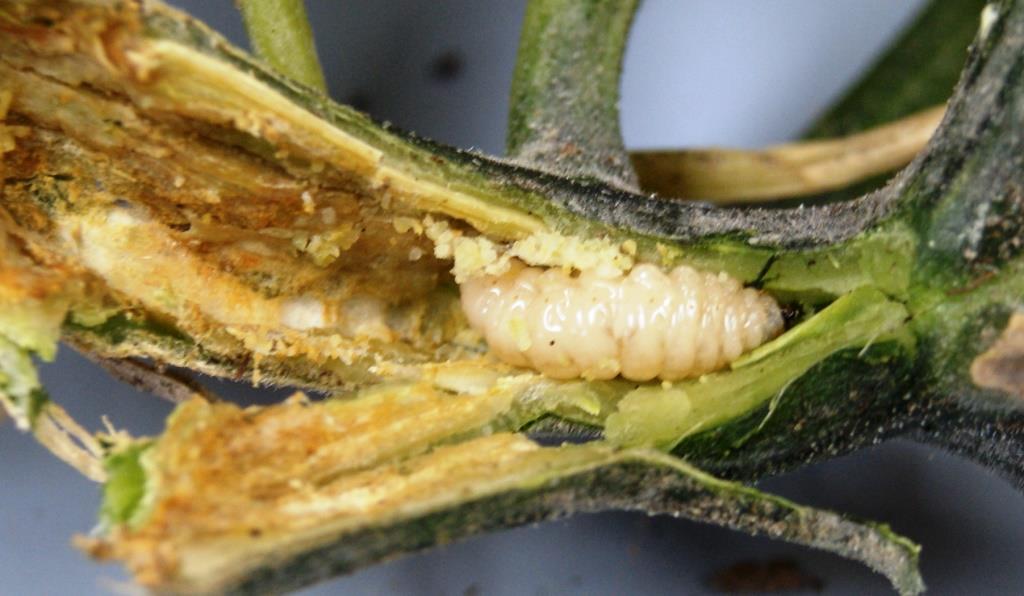
by Matthew Orwat | Jul 15, 2013
Why is my squash wilting? Assuming you have been giving your vegetable garden adequate water, the Squah Vine Borer may be the cause.
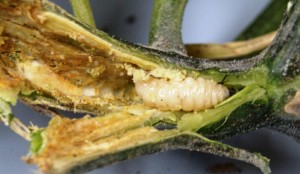
Squash Vine Borer larva. Image Credit Matthew Orwat
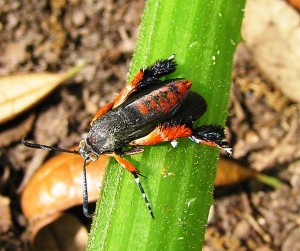
Adult Moth. Image Credit Theresa Friday
Unfortunately presence of the squash vine borer, the larval form of a clearwing moth, is usually noticed only after damage is permanent. Prevention is possible with early recognition through vigilant scouting.
The adult moth is common in gardens throughout Northwest Florida, and is easily recognizable due to its black and orange coloration.The 1/2 inch moth is active during the day and will lay a single tiny orange egg at the base of healthy squash plants.
It only takes a week for the egg to hatch and for the larva to bore into the stem. Once the larva in inside the stem, it chews its way up the stem, blocking the transport of water from the roots to the shoots. By the time wilting is noticed, total blockage of the water conducting tissue (Xylem) is likely.
If the moth is noticed in the garden, preventitive application of Bt (Bacillus thuringiensis) or pyrethroid (permethrin or bifenthrin) insecticide to the base of the stem may stop their incursion into the vine. Yellow traps full of water can be put out to monitor for them, since they are attracted to anything yellow.
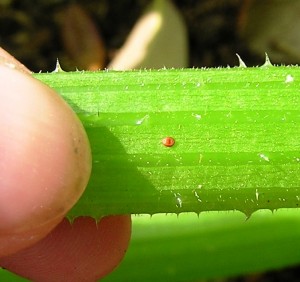
Squash Vine Borer Egg. Image Credit Theresa Friday
If the vine is already affected, insecticide applications will not help. There is a slim chance of saving it by cutting out the larva. While performing this task make sure to preserve the stem and bury the stem of the plant in a few inches of protective soil. The plant may grow new roots and resume production.
For more information about the Squash Vine Borer, proceed to this University of Kentucky article. To learn more about pests of Cucurbits, check out this informative UF / IFAS publication, Insects Management for Cucurbits.
by Matthew Orwat | Jun 21, 2013
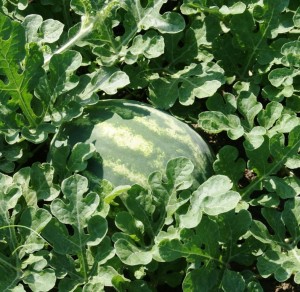 Watermelon harvest in the central Florida Panhandle is actually a week or two late, but there will be plenty of melons at the Festival
Watermelon harvest in the central Florida Panhandle is actually a week or two late, but there will be plenty of melons at the Festival
This slight delay in harvest is due to the near 100 degree temperatures and lack of pollinators present. Flowers have been closing early in the day due to heat, and this further reduces pollination. Pollination conditions have improved as temperatures have eased off the near 100 degree mark. Watermelons are running and flowering well due to the plentiful recent rains. In Washington and Holmes counties, melon cutting should begin sometime between June 20th and June 26th.

by Matthew Orwat | Jun 17, 2013
Although black or white streaks are shocking when they appear on an otherwise healthy lawn, the incidence of slime mold is rarely harmful.
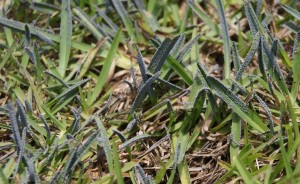
Closeup: Slime Mold in Centipedegrass. Image courtesy Matthew Orwat
Slime mold is actually caused by the reproductive structures of an array of different organisms, classified as plasmodia or Protista, which are regularly present in the soil. They are often mistaken for fungi. The different types are referred to as myxomycetes or dictyosteliomycetes. They usually appear on warm humid days in late spring or early summer after extended periods of rain. This extended period of heat and humidity, as is currently being experienced in the Florida Panhandle, initiates the perfect climate for slime mold development.
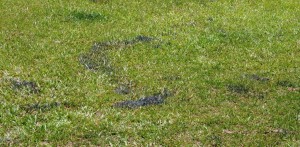
Slime Mold in Centipedegrass. Image Courtesy Matthew Orwat
As depicted in the picture above, slime mold makes the lawn look like it was just spray-painted with black or grey paint. The round fruiting bodies, called sporangia, carry the spores which will give rise to the next generation of the “mold”. After a few days the sporangia will shrivel up, release the spores and leave no noticeable trace on the lawn.
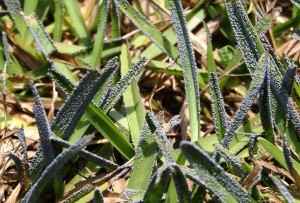
Slime Mold Sporangia. Image Courtesy Matthew Orwat
Currently, no fungicide exists to control slime mold because chemical control is not necessary. An excellent method to speed up the dissipation of slime mold is to mow or rake the lawn lightly. This will disturb the spores and hasten their departure. Another effective removal method is to spray the lawn with a forceful stream of water. This process washes off the slime mold sporangia and restores the lawn to its former dark green beauty.
Excessive thatch accumulation also increases the probability of slime mold occurrence.
For more information consult your local county extension agent or read the Alabama Cooperative Extension publication Slime Mold on Home Lawns.
by Matthew Orwat | May 9, 2013

Adult Scale – Image Courtesy Lyle Buss
Many different species of scale insect infect citrus in North Florida, and mid spring is usually when gardeners notice them on their fruit trees and ornamental shrubs. Many different species of scale affect Florida homeowners and cause a host of problems in the garden and landscape. Citrus is particularly prone to scale infestations in North Florida.
The Satsuma Tangerine, Citrus unshiu, is currently a fruit that is highly prized by home gardeners in North Florida. Now is the time to act to prevent heavy scale infestations since weather is warming and control methods cannot be used when daytime temperatures are very hot. This pest has already been observed at multiple locations throughout the Florida Panhandle in both home gardens and commercial production areas.
Scale often reduces tree vitality by ingesting sap that would otherwise be used by the tree for growth and fruit production. They may also cause premature fruit drop and defoliation. A secondary pest that may occur as result of Scale is Sooty Mold. Sooty Mold lives off of the surgery secretions of the scale and can cause citrus leaves to look black and eventually drop.
The good news is that Scale is relatively easy to control when managed in winter or early in the spring growing season. From October through mid-May growers should use Horticultural Oil to control scale, particularly horticultural oil containing petroleum products. These products deprive scale insects of oxygen. This will smother them, but dead insects will need to be washed off if complete removal is desired.
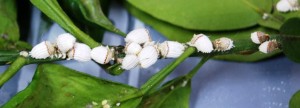
Cottony Cushion Scale – Image Courtesy Matthew Orwat
Applications should be timed correctly since horticultural oil applications can burn plants once the outdoor temperature reaches 94 ® F. A good rule of thumb is to apply horticultural oil on cool and cloudy days to minimize leaf damage. Always consult the label of each individual product before application and never apply more than the recommended amount. This last statement is especially crucial for horticultural oil applications, since increased rates are highly likely to damage plants. For more information, please consult this UF / IFAS publication on Citrus Scale and the Citrus Pest Management Guide.
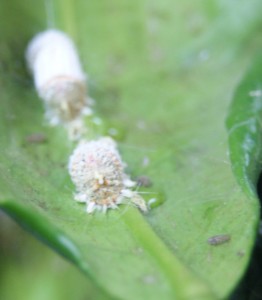
Cottony Cushion Scale – Image Courtesy Matthew Orwat













